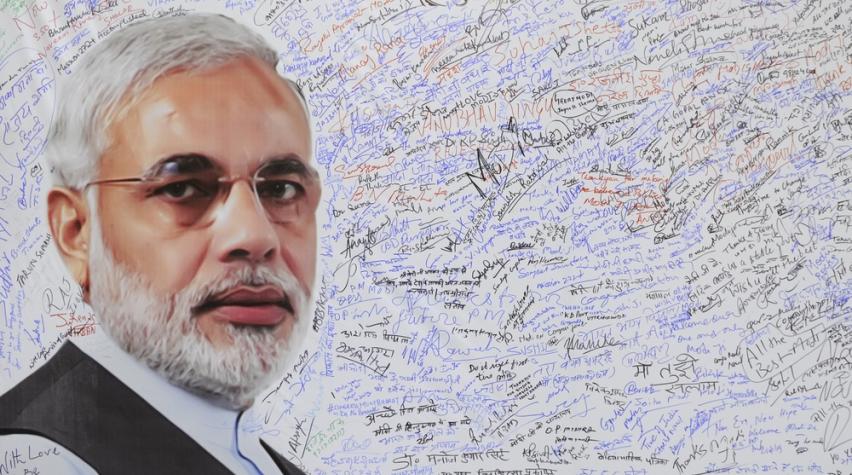
India's tumultuous general election is over, and Narendra Modi and his Bharatiya Janata Party just won a smashing victory, after pitching himself - particularly to young, urban voters - as a clean energy and jobs creator, and signaling a energy revolution to end the country's blackouts and revive economic growth. His record as the "can-do" minister of industry-friendly Gujarat, which has added jobs while running a power surplus, helped propel him to victory.
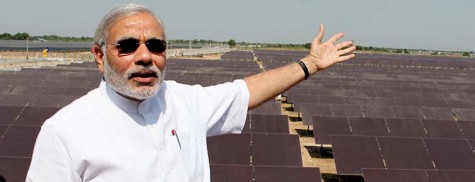
Now Modi has an overwhelming mandate to rejuvenate India's economy, while addressing energy poverty and access. He plans to extend Gujarat's success nationwide by enabling every home to run at least one light bulb by 2019. Narendra Taneja, convener of the energy division at Modi's Bharatiya Janata Party, said, "We look upon solar as having the potential to completely transform the way we look at the energy space."
The saffron revolution
Along with new coal plants, Modi built Gujarat's envied power surplus with a dramatic rise in solar capacity, which has been hailed as the "saffron revolution" by the coal-dependent nation. Moreover, Gujarat offers 24x7 electricity to homes and businesses, as it enjoys the highest increase of solar in India - 40 percent of the country's nearly 3,000MW. In part, Modi jump-started the solar buildout by creating India's first incentives for large scale, utility solar power. Today over four percent of Gujarat's installed capacity, around 825 megawatts, comes from the sun.
A dysfunctional grid
Modi will confront a formidable obstacle to a nation-wide saffron revolution: the country's unreliable and creaky grid, which every politician admits is a mess. Since 400 million people lack access to electricity, and the outgoing Prime Minister, Manmohan Singh, already missed a self-imposed target to supply the rural poor with power by 2012, modernizing the grid will be a daunting task. Actually, it will take more than a patched up grid to bring electricity to the rural poor. Unfortunately, Modi has been vague about innovations like micro-grids or pay-as-you-go solar financing models. But back to the grid bad news: India has suffered a power deficit every year since at least 1984. According to Bloomberg, the shortfall has blocked efforts to fight slowing economic growth accompanied by Asia's fastest inflation, primarily because power retailers are currently behind on $2.5 billion of payments to their suppliers, reducing their ability to provide electricity to customers. The problem is self-inflicted. India generates 68 percent of its electricity from coal supplied by the state monopoly Coal India, selling it at a 44 percent discount to global prices. However, Coal India is unreliable, shorting retailers whose only fallback is producing power with expensive overseas coal. Then they're unable to make a profit with the heavily regulated, low, consumer energy prices. Over time, Modi's planned move to solar would impact this chronic problem. But grid problems don't end with coal. Electricity theft is pervasive: 15 to 30 percent of power is lost to illegal hookups, bill fraud, or nonpayment. The World Bank estimates that stealing from the grid reduces India's GDP by 1.5 percent. Bloomberg quoted S.L. Rao, the head electricity regulator from 1998 to 2001, saying that India's utility industry "has reached a stage where either we change the whole system quickly or it will collapse." He than added, "The power sector needs tough politics, and the only person in politics today who might be capable of that kind of toughness is Modi." India's state-by-state control of the power grid is another obstacle, where local governments ensure free or below-cost electricity to farmers while buying it from generators using ever increasing debt. Modi solved this problem in Gujarat by splitting electricity for agriculture from the rest of the market. Farmers get cheap power, but for only a few hours a day. Uninterrupted power is sent to paying businesses, households and industries. Modi also removed political appointees from state ventures and power utilities. Then he made the professionally run companies autonomous, helping them to become profitable.
A canal-based solar project
In addition to policy changes, Modi pushed two innovative solar power concepts. In 2012, he inaugurated the world's first canal-based 1 MW solar power demonstration project.
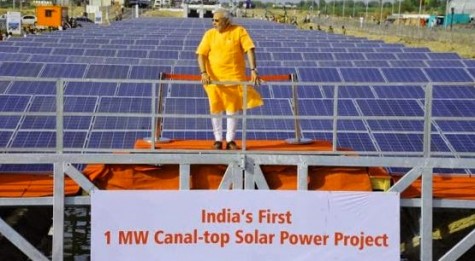
By building the solar power panels directly over a 750 meter stretch of canal, the pilot project eliminated the need to buy new land. Additional benefits were discovered. While generating clean electricity, the over-arching panels act as a cover and prevent about 90 million liters of water evaporation every year. Compared to a typical installation, these solar panels also produce 15 per cent more power because the water underneath keeps them cooler and more efficient in India's hot sun.
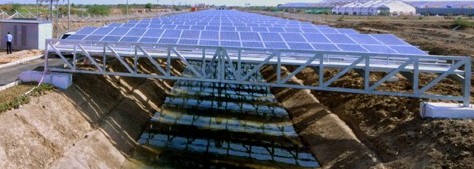
The length of entire canal network of the planned project is around 85,000 km. Even if only 10% of the existing canal network is used, it will have a potential capacity of 2,200 MW.
Rent your roof
Next Modi borrowed a trick from developed countries and started a rent-your-roof plan in Gandhinaga, the capitol of Gujarat. After it started operation last year, according to the Financial Express, homeowners throughout the city now rent their roofs to solar developers like SunEdison. To encourage sign ups, home owners can walk into a local center and enroll.With a planned capacity of five megawatts, four megawatts will cover government buildings and one megawatt will blanket local homes.
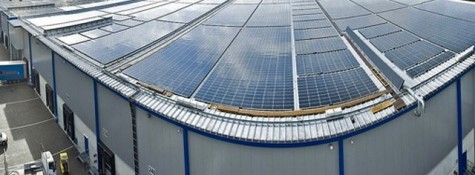
Last year, nearly 260 small households participated. Already, 760 KW of residential leases get at least Rs. 3 per unit of energy generated. "We are now taking this program to other cities where we plan to generate 25 megawatt of energy," said Saurabh Patel, Gujarat minister for Energy. Realistically, Modi's blueprint for India's transformation will be messy, and his record shows that he's not too worried about the negative effects of coal. After all, Gujarat is already home to some of the biggest coal plants in the country, which includes Tata Mundra, the first in a series of 16 mega coal power plants being built to avert the power crisis. But he also promises to send the country in a completely new direction.


